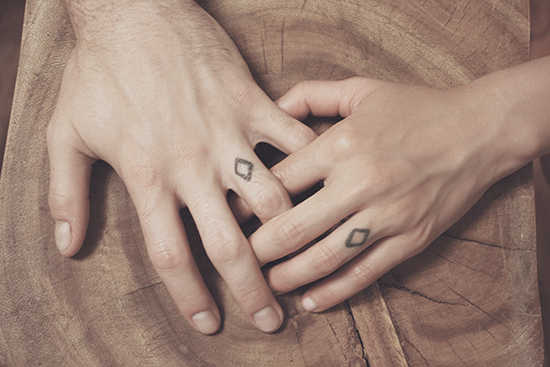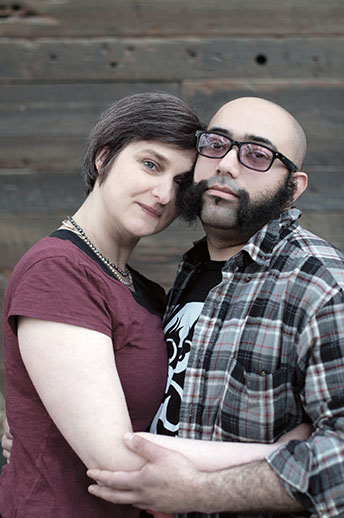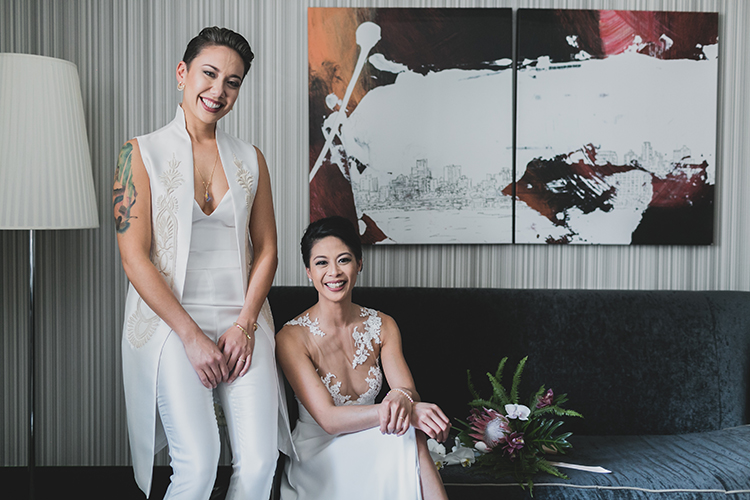The June Wedding Issue is on the streets now, and you can pick it up at any of these locations. But we’ll be posting some of the tips and love stories we collected for the issue on the blog over the next two weeks. Stay tuned.
Morgan Le Maitre and Ryan Brunton chose commitment diamond tattoos instead of rings to accommodate their rock climbing lifestyle
Bare Knuckled Brides
The clandestine plans of Romeo and Juliet were exactly the kind of forbidden love that Pope Innocent III was trying to avoid when he decreed mandatory periods of engagement in 1215. To mark our betrothal to one another, we’ve used many kinds of symbols—including the sewing thimble that practical Purtians gave to their future wives—but rings have become the default.
It’s a relatively new tradition, however, to get engaged with a diamond ring. Simple bands and many kinds of stones, including pearls, were commonplace until a 20th century marketing genius convinced us that “a diamond is forever,” and therefore the only way to show our undying love.
The safest bet if you’re set on a diamond solitaire is a family heirloom, a trip to a vintage shop, or picking a jeweler who knows how problematic diamonds can be and has worked to source their stones ethically. According to a 2013 report in Foreign Policy, the “Kimberly Process,” certificates that attest to a diamond’s provenance are easily (and often) faked, and the diamond industry, centered in the Indian city of Surat, is rife with corruption and abuse. “Blood diamonds” or “conflict diamonds” are mined to fund wars around the world, and many others are often mined, cut and polished by enslaved or abused workers. Some jewelers, like Philadelphia’s Bario Neal, go beyond trying to ethically source diamonds and look at all of their materials; they are the only local jeweler who is a member of the nonprofit advocacy group Ethical Metalsmiths.
But take heart. The pendulum is swinging back to a place where couples are free to choose engagement and wedding jewelry that’s meaningful for them—or no jewelry at all. When rock climbing partners Morgan Le Maitre and Ryan Brunton first met, they were on the ropes and focused on keeping one another alive. The immediate and complete trust that they felt led to an engagement just two weeks later. Knowing that rings were dangerous during climbs (and not a symbol they felt a strong connection to anyway), they decided to forgo an engagement ring and wedding bands entirely. Instead, they added to their collection of tattoos, choosing black commitment diamonds of ink for their ring fingers. They had an intimate celebration at local sustainable restaurant Southwark.
Rings are just one part of weddings that are up for consideration. As more and more gay couples are legally allowed to wed—the Supreme Court will rule in June whether marriage is a universal right—you can be sure that rules of engagement will continue to evolve, and new traditions will take hold.
Photos by Chloe Berk
Phoebe and Christian: Long road, simple wedding
Mixologist pair Phoebe Isabelle Easmon and Christian Raphael Gael are beloved for their creative cocktails and their personal style—Gael is the rare man who owns his own tuxedo. Their hands spend lots of time in soapy sinks, so wearing traditional rings is a non-starter. Phoebe’s pearl engagement necklace is a part of a long tradition of her own. “My dad got me my first pearl necklace when I was twelve,” she says. Christian adds that his gift is also practical, and for him the pearls symbolize their relationship. “The oils in your skin are what keep them lustered, so it’s kind of a relationship in and of itself,” he says. “It made sense to kind of symbolize continued refreshment of a relationship between two people that needs her to keep it viable.” Options for wedding bands include tough tungsten rings or tattoos.
A (nearly) stress-free wedding:
The couple plan to elope. “The wedding is for us,” says Phoebe. “It shouldn’t be for anybody else.” They’ll then have a series of celebrations with friends and family. They believe their long engagement has staved off any interference in how they might choose to celebrate. Phoebe says her family is traditional (her father is both a jewelry maker and a minister), but at this point, “They mostly just want us go to go ahead and get married.” With Phoebe giggling beside him, Christian wryly observes, “We’ve been engaged for quite a while now … actually going through with it and marrying is something that becomes ransomed a little bit. They’re much more excited to have it be done with than to give you much trouble about exactly how you go about it.”
Cutting down on travel:
Being mindful of how their nuptials will affect their guests is at the top of their planning list. “You don’t want your wedding to be a hardship for your guests,” says Christian. “Some people are still doing destination weddings … some of us are being more realistic.” They’ll travel to North Carolina where Phoebe’s family lives to avoid people traveling to them. A Sunday or Monday barbecue in Philadelphia will help ensure that their restaurant industry colleagues and friends will be able to raise a glass with them.
Simple threads:
They enjoy dressing up, but don’t want people to go out and buy special clothes for their celebration. Phoebe is considering a nonwhite afternoon or tea dress that she can wear again. “We still have my grandmother’s dress. It’s preserved in a box … I don’t see the point in doing that. And I don’t want to spend all my money on it. We’re all working so much harder to make less money … spending a month’s wages on a dress I’m only going to wear once is not really a viable option.”
Cocktails and flowers:
The drink list will likely be local beer and a custom punch dreamed up by the couple; they’ll get minimal flowers grown locally, or use the orchids that Phoebe grows at home for decorations. Potted plants or herbs may serve as favors.










